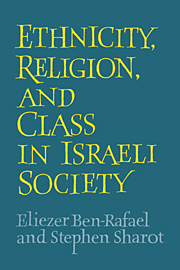Book contents
- Frontmatter
- Contents
- Acknowledgments
- I Theoretical and empirical background
- II Social patterns and behavior
- III Identities and images
- 8 Ethnic consciousness
- 9 Class consciousness
- 10 Religious, ethnic, and class divisions: convergent or crosscutting?
- IV The impact of stratification
- V Social cleavages: an overview of Israeli society and some theoretical implications
- Appendix A The sample
- Appendix B Deprivation index
- Appendix C Indexes of ethnic identification
- Glossary
- Notes
- References
- Index
8 - Ethnic consciousness
Published online by Cambridge University Press: 12 September 2009
- Frontmatter
- Contents
- Acknowledgments
- I Theoretical and empirical background
- II Social patterns and behavior
- III Identities and images
- 8 Ethnic consciousness
- 9 Class consciousness
- 10 Religious, ethnic, and class divisions: convergent or crosscutting?
- IV The impact of stratification
- V Social cleavages: an overview of Israeli society and some theoretical implications
- Appendix A The sample
- Appendix B Deprivation index
- Appendix C Indexes of ethnic identification
- Glossary
- Notes
- References
- Index
Summary
Socio-economic and cultural interpretations
In chapter 3 we compared the socio-economic interpretation which argues that edot ha'Mizrach have become the basis of an emergent ethnic identification (Swirski, 1981) and the cultural interpretation that focuses on the edah. A prominent example of the cultural approach is that of Deshen (1972, 1976) who presents persistence and change of customs and practices as outcomes of a conflict between an identification with the edah and an identification as Israeli citizens. Over some issues, particularly those that encroach upon focal aspects of cultural heritage, a separatist stance is taken, but in most cases compromises are made that allow for the continuation of a separate edah identity within the broader compass of the national Israeli identity.
One problem with both the socio-economic and cultural approaches to the ethnicity of Middle Eastern Israelis is that they are difficult to reconcile with the common ideology in Israel of a Jewish melting-pot or “fusion of the exiles.” We asked respondents, “What is your attitude toward mizug ha'galuyot (fusion of the exiles) and the disappearance of different groups of origin within one people?” The great majority of respondents (90%) of both European and Middle Eastern origins, indicated either “positive” (23%) or “very positive” (67%); very few indicated either a negative or neutral position (for similar findings see Peres, 1969).
- Type
- Chapter
- Information
- Ethnicity, Religion and Class in Israeli Society , pp. 119 - 135Publisher: Cambridge University PressPrint publication year: 1991

